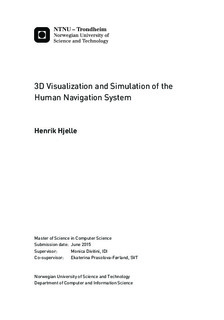| dc.description.abstract | The aim of this thesis is to investigate how 3D visualizations and virtual reality can be used to make the human navigation system understandable for the general public.
To do this, a 3D visualization of the human navigation systems components in the brain was created using Second Life. In addition, a simulation of how the cells in this system works was created with the same platform.
These two types of visualization were used to see if they gave any learning outcome in relation to the human navigation system to a set of evaluation participants from the general public.
The evaluation was divided between a qualitative and a quantitative part, where participants conducted both the visualization and the simulation. After the conduction, they answered on some questions from a questionnaire or an interview.
The results in this thesis is based on these evaluations. The results show that both the visualization and the simulation does contribute in giving the general public an understanding of the human navigation system.
Based on the experiences and lessons learned though the project, a nine point recommendation for creating educational 3D visualizations for the general public was created. | |

